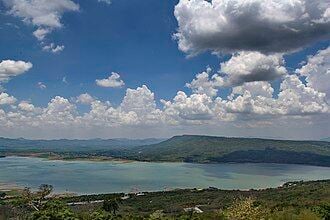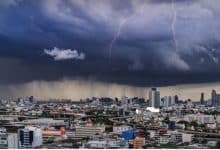Rain reigns: Nakhon Ratchasima’s reservoirs overflow with joy as planting season gets a splashy boost

Heavy rainfall in Nakhon Ratchasima provided a significant boost to the province’s reservoirs, ensuring sufficient water management during the planting season. The unexpected downpour is due to a high-pressure system affecting Thai provinces and neighbouring countries and is predicted to continue until June 10.
In the lower north-eastern region, the heavy monsoon resulted in a 70% chance of thunderstorms and heavy rainfall which affects several provinces, including Mukdahan, Yasothon, Amnat Charoen, and Ubon Ratchathani. The Department of Meteorology reports that the province of Nakhon Ratchasima is also affected, with a 60% chance of thunderstorms and heavy rain covering the entire area. The most significant rainfall is expected to occur in Pak Chong, Pak Thong Chai, Wang Nam Khiao, Conburi, and Suengsang districts.
The continuous rain has led to an increase in water volume in four major and 23 medium-sized reservoirs in Nakhon Ratchasima. As of now, the average water storage of the four large reservoirs is at 50.60%, equivalent to 448 million cubic metres, and can be used at 48.41% or 410 million cubic metres. In the case of the 23 medium-sized reservoirs, the average remaining water storage is 160 million cubic metres, or 48.58%, while the usable water stands at 135 million cubic metres or 44.38%. The combined water storage in both large and medium-sized reservoirs amounts to 608 million cubic metres, or 50.05%, with usable water at 546 million cubic metres, or 47.34%.
Irrigation authorities have expressed confidence in their ability to manage water resources adequately to prevent any negative impact during the planting season, even in the event of reduced rainfall.
Meanwhile, continuous rainfall and flooding have led to warnings in 43 provinces in Thailand, affecting 70% of the region. The Thai Meteorological Department urged citizens to be cautious of potential dangers amidst the downpour, including landslides and flash floods.
The heavy rainfall is a result of a strong monsoon trough passing through Myanmar, affecting parts of northern, northeastern, central, and eastern Thailand, as well as the southern region. Additionally, a low-pressure trough covering the coast of China and the southern part of the Andaman Sea, combined with the southwest monsoon, has contributed to this weather pattern. Read more HERE.
Latest Thailand News
Follow The Thaiger on Google News:


























